Key takeaways:
- Understanding and managing project timelines is essential to ensure high-quality outcomes and maintain team morale.
- Effective timeline management fosters accountability, clarity, and better communication, preventing costly miscommunications and duplicated efforts.
- Utilizing tools like Trello, Asana, and Gantt charts can significantly enhance task organization and project visibility.
- Regular check-ins and celebrating small wins are crucial for team alignment and maintaining motivation throughout the project lifecycle.
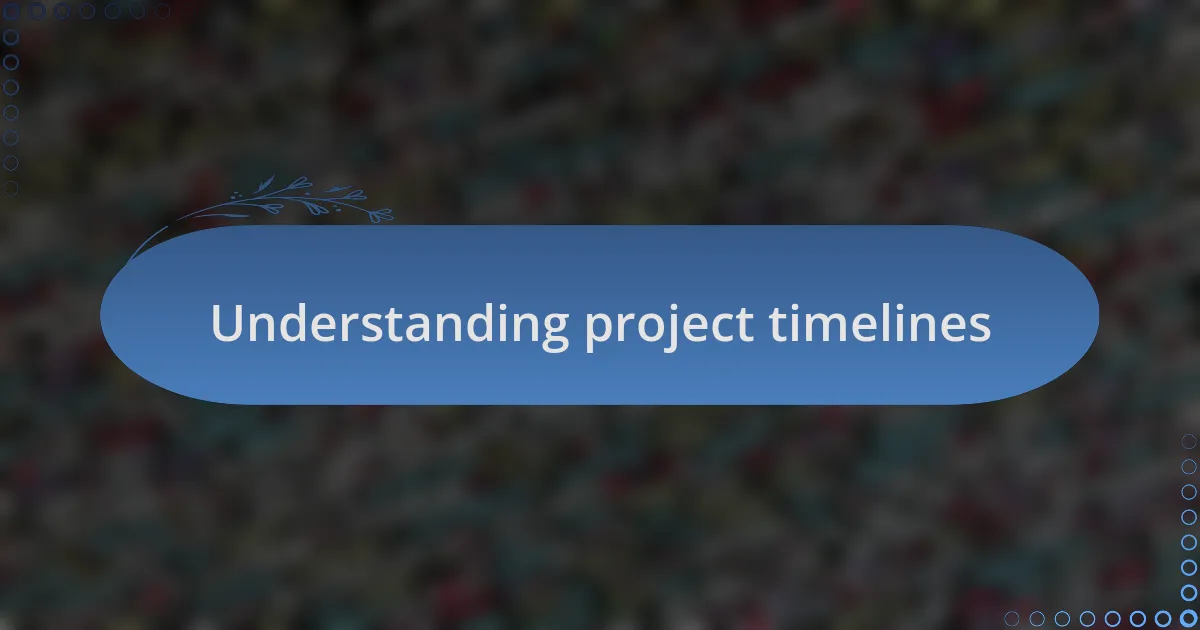
Understanding project timelines
Understanding project timelines is crucial in web development because they serve as the backbone of the entire project. I recall a time when I underestimated the complexity of a client’s request, resulting in a rushed timeline that affected the quality of our work. If I had taken the time to analyze the requirements more thoroughly, I could have avoided that stressful situation.
In my experience, breaking down a timeline into manageable phases can significantly enhance clarity and focus. It’s like mapping out a road trip; each stop along the way represents a milestone that guides you forward. When I set clear checkpoints, I find it not only helps my team stay on track but also allows us to celebrate small victories, which keeps morale high.
Moreover, it’s essential to remain flexible when managing timelines, as unexpected challenges often arise. Have you ever planned a perfect schedule only to have things go awry? I’ve found that being adaptable can turn potential derailments into opportunities for innovative solutions. Embracing this mindset has helped me maintain a balanced approach to project management and ensure that we deliver high-quality results, even when faced with delays.
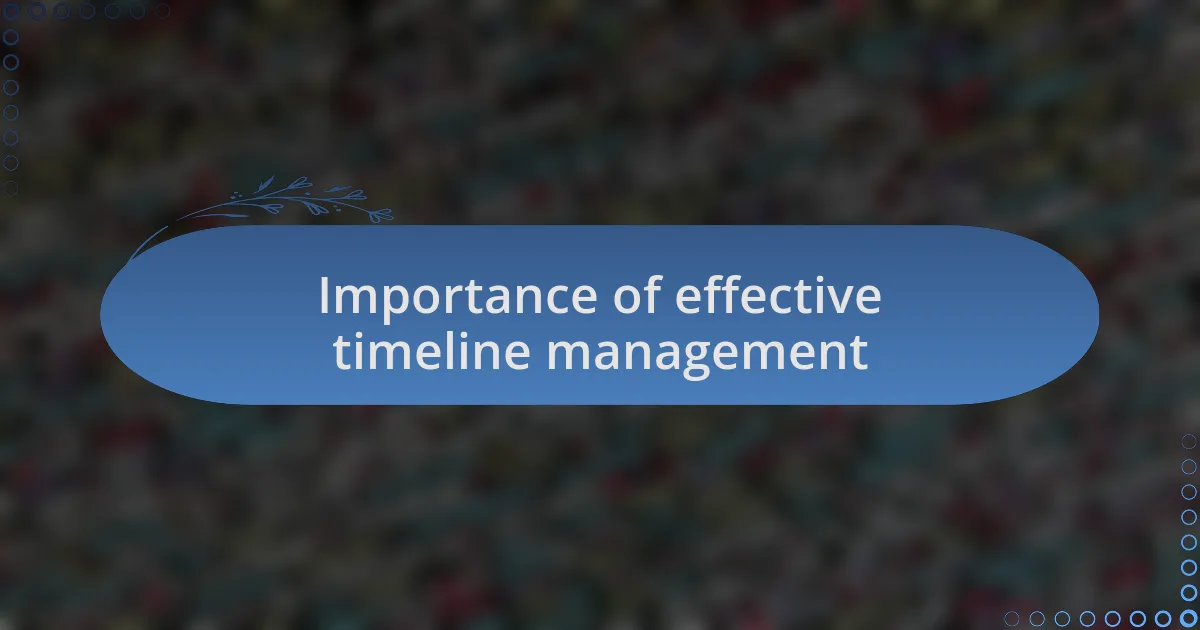
Importance of effective timeline management
Effective timeline management is vital in ensuring that projects are completed on time and within budget. I remember a project where I quickly overlooked the importance of setting realistic deadlines. This oversight created a ripple effect, leading to rushed decisions and ultimately a product that didn’t reflect our usual standards. It reinforced to me just how critical it is to give timelines the attention they deserve.
When I think about it, a well-structured timeline can be the difference between chaos and order in a web development project. I’ve seen firsthand how a clear timeline not only sets expectations for the team but also for clients. It creates a sense of accountability that keeps everyone aligned—kind of like the gears in a clock, each part working together to ensure everything ticks along smoothly.
Moreover, managing timelines effectively fosters better communication within the team. There was a time when miscommunication around deadlines led to duplicated efforts, which was frustrating for everyone involved. Have you experienced that? I learned the hard way that maintaining an open dialogue about timelines helps prevent such pitfalls and ensures that everyone is on the same page, paving the way for a more productive and harmonious working environment.
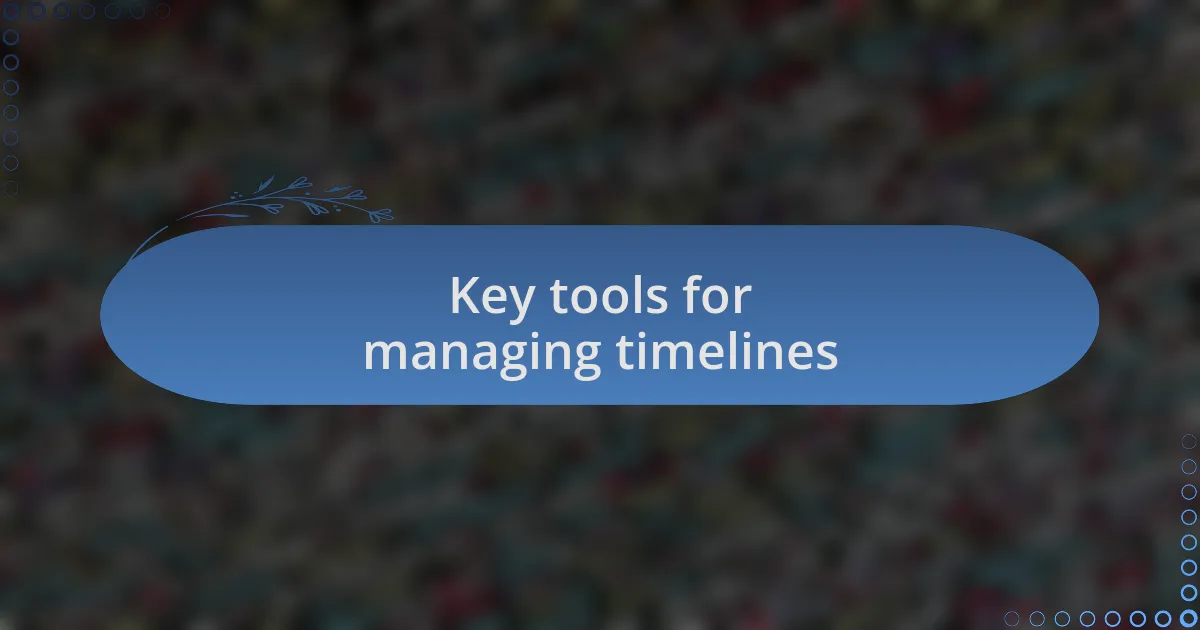
Key tools for managing timelines
When it comes to managing project timelines, I’ve found that tools like Trello and Asana are absolute game-changers. These platforms allow me to visually organize tasks with flexible timelines and deadlines, which has been invaluable during complex projects. I remember using Trello for a recent website overhaul; being able to drag and drop tasks made it easy to adapt as new challenges arose.
Another tool that has dramatically improved my timeline management is Gantt charts. Seeing tasks laid out over time provides clarity on dependencies and critical paths, which, honestly, helps prevent unnecessary bottlenecks. One time, when I created a Gantt chart for a client project, it opened my eyes to potential pitfalls we hadn’t considered, ultimately saving us from a last-minute scramble. Have you experienced something similar?
Lastly, I can’t underestimate the power of Google Calendar for syncing timelines across team members. It streamlines scheduling and ensures that deadlines are in everyone’s sight. I remember a particularly hectic period when we coordinated weekly check-ins using shared calendars; this not only kept us accountable but also sparked conversations that led to creative solutions. Have you ever felt the difference that a shared calendar can make?
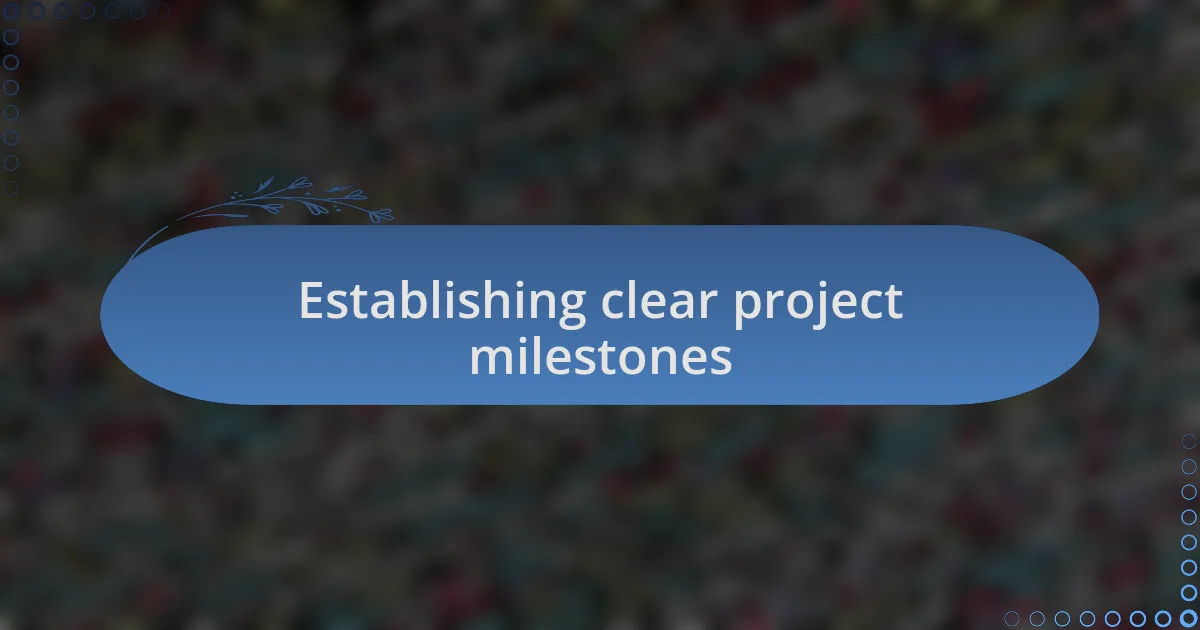
Establishing clear project milestones
When establishing clear project milestones, it’s essential to define what success looks like at each stage. I remember when I first started mapping out milestones for a web development project; I felt overwhelmed until I realized that breaking things down into smaller, achievable goals made a world of difference. It transformed my perspective from a daunting timeline to a series of manageable steps that guided my team’s progress.
One strategy that works well is setting specific, measurable milestones. For instance, during a recent project, I decided to aim for a test version of the website by a certain date, focusing on completing the design and primary functionalities by then. This not only motivated the team but also allowed us to gather feedback sooner and pivot if necessary. Have you ever noticed how clear targets can spark your team’s energy?
Moreover, I’ve found that involving the entire team in milestone planning fosters ownership and accountability. In one project, I facilitated a brainstorming session where team members suggested milestones based on their expertise. This collaborative effort not only generated milestones that everyone was excited about but also built camaraderie within the group. Have you tried involving your team in milestone discussions? It can lead to innovative ideas and a shared commitment to meeting those goals.
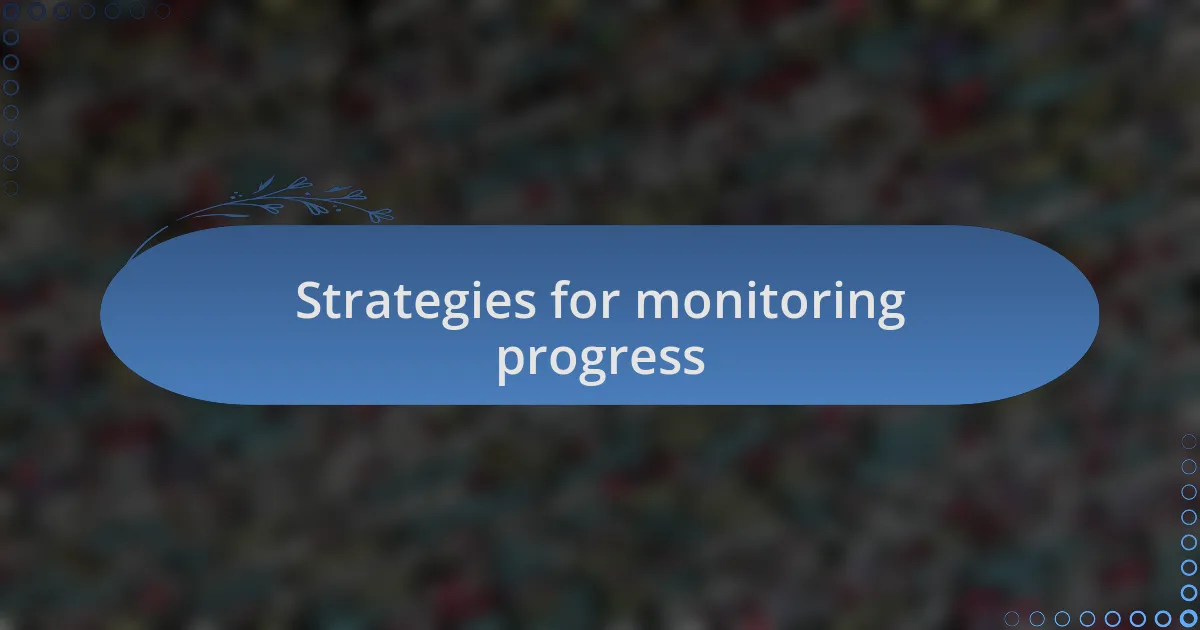
Strategies for monitoring progress
Monitoring progress in a project is crucial for staying on track. One effective strategy I’ve employed is using visual project management tools like Gantt charts. When I first integrated a Gantt chart into my workflow, I was amazed at how clearly it showcased our timeline and task dependencies. It’s like having a bird’s-eye view of the entire project; have you ever used similar tools? They can really help in pinpointing potential delays and keeping the team aligned.
Another technique I find invaluable is holding regular check-ins with the team. These brief sessions act as a pulse-check, allowing everyone to share their updates and concerns. I recall one instance where a team member flagged a potential roadblock during a meeting that we hadn’t anticipated. By addressing it immediately, we not only averted a delay but also fostered a supportive atmosphere where everyone felt comfortable voicing their thoughts. Isn’t it empowering when team members feel heard and valued?
Finally, I always emphasize the importance of celebrating small victories along the way. One project I managed had us completing a significant feature ahead of schedule, and we took that moment to celebrate as a team. It wasn’t just about delivering the project; it was about recognizing our hard work and motivating each other to keep pushing forward. Don’t underestimate the power of acknowledgment—how do you celebrate progress in your projects?
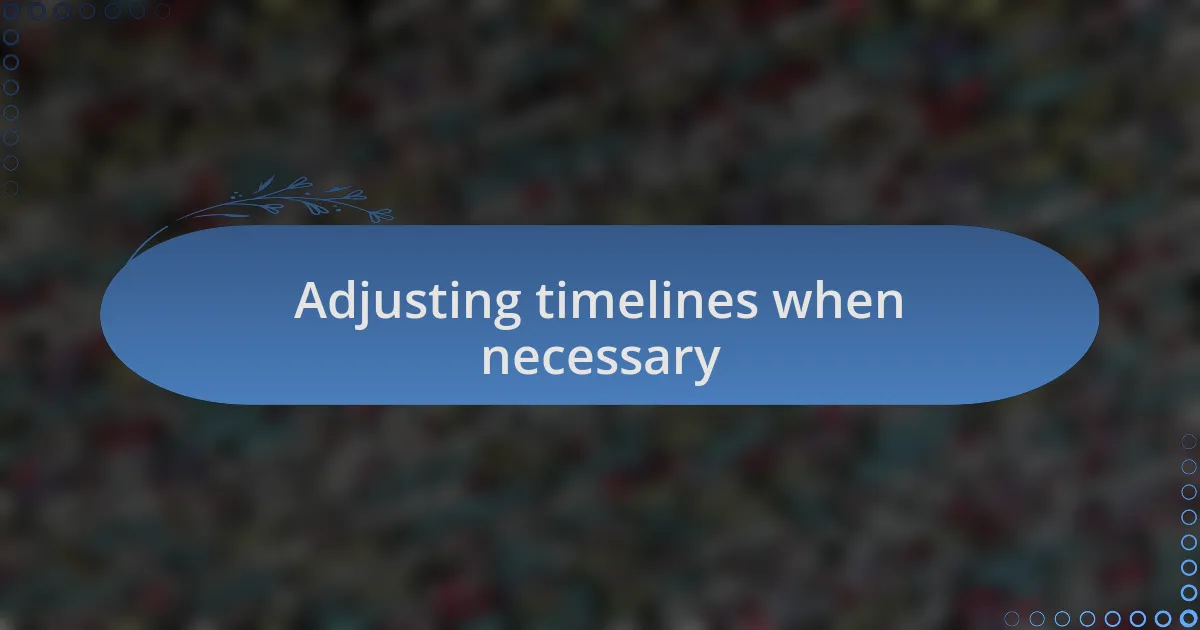
Adjusting timelines when necessary
Sometimes, you just have to be flexible with your timelines. I remember a project where we were on a tight schedule, and a sudden change in client requirements threw us for a loop. By reassessing our timeline and breaking tasks into smaller, manageable chunks, we adapted quickly. Have you faced a situation where you had to adjust your plans unexpectedly?
While it’s important to stick to deadlines, I’ve learned that knowing when to pivot is equally crucial. One time, I doubled down on team collaboration by encouraging open discussions about our pace. This led to a realization that we needed extra time for user testing to ensure quality. It was a hard decision, but ultimately, it enhanced the final product. Doesn’t it feel reassuring to know when to prioritize quality over speed?
Communication is key when adjusting timelines. Keeping everyone informed about changes helps to maintain morale and project momentum. I’ve found that addressing timeline adjustments swiftly with the team fosters understanding rather than frustration. Have you ever faced pushback on deadline changes? I’ve navigated this by being transparent about the reasons, which often helps the team remain motivated and engaged.
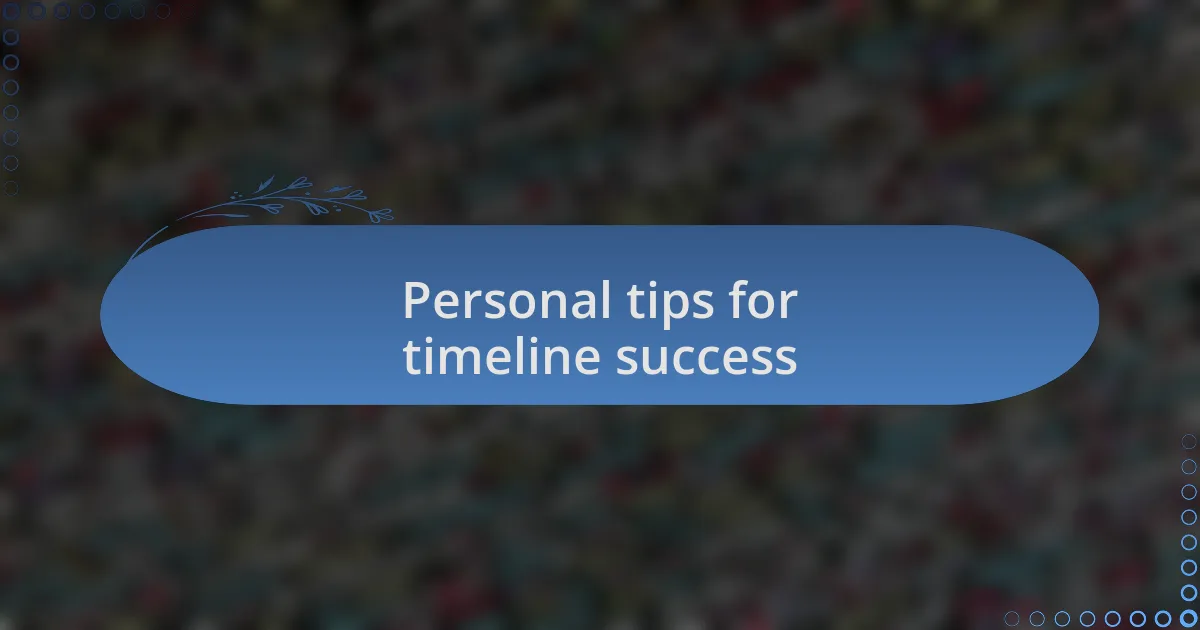
Personal tips for timeline success
When I think about managing timelines, I can’t stress enough the value of setting realistic expectations right from the start. Early in my career, I once promised a client a rapid turnaround on a website redesign. As the deadline approached, I felt the pressure mounting, and I realized I had underestimated the complexity of the project. That experience taught me that being honest about what’s achievable can reduce stress for everyone involved. Have you ever felt overwhelmed by self-imposed deadlines?
Another tip that I find immensely helpful is to incorporate regular check-ins throughout the project. During one project, my team and I started holding brief weekly updates—it was amazing how this small shift opened up dialogue about our progress and potential roadblocks. These discussions ensured we remained aligned and could adjust our strategies as needed. Doesn’t it feel great to have that sense of shared purpose and accountability?
Lastly, I always make it a point to celebrate milestones, no matter how small. I recall a project where we hit a significant deadline, and taking a moment to acknowledge it lifted everyone’s spirits. Celebrating these wins fosters a positive work environment and keeps motivation high. After all, what’s the point of hitting those timelines if the journey is stressful? How do you celebrate achievements in your projects?